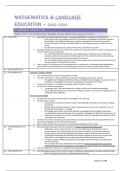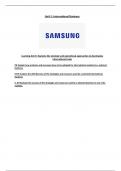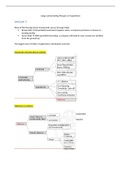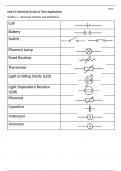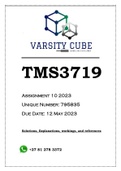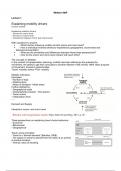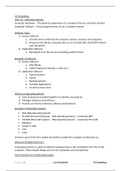EDUCATION – 2022/2023
1. EMERGENT LITERACY (EL)
ROHDE (2015): ‘The Comprehensive Emergent Literacy Model: Early Literacy In Context’
(a) Introduction • Learning to read has long been held as a necessary ingredient for success in school and life
o Early skills, known as Emergent Literacy (EL) include the knowledge and abilities related to
the alphabet, phonological awareness, symbolic representations, and communication
o The comprehension of these concepts builds over time beginning when children are very
young
o EL has been recognized as a vital content area in preschool curriculum
• Existing models of EL tell only part of the story: they focus on discrete skills but without a perspective of
the environment surrounding them
o Yet, understanding these skills of EL and recognizing the importance of the setting and
context, is critical in ensuring that children gain all of the preliminary skills and awareness
they will need to become successful readers and writers
o The new model strives to explain how EL can be viewed as an interactive process rather than
simply a series of individual components
• The concept of EL evolved and is now recognized as a combination of developmentally appropriate
practice with an intentional focus on providing opportunities for children to learn about literacy
(b) Early Research in EL
(c) Early Models of EL Outside-In, Inside-Out Model
• Two interdependent domains of processes and skills
• Outside-In processes = used to describe conceptual knowledge (e.g. function of print)
o Recognizes that reading is ineffective without comprehension strategies, including the use of
background knowledge, to decipher the message of the writer to the reader
• Inside-Out processes = procedural knowledge related to skills of literacy
• Continuum of skills and concepts
o “Language units” that demonstrate the merger of skills and conceptual knowledge
o To successfully transition into conventional reading, children must have both procedural and
conceptual skills of literacy
Four-component Model
• Includes both conceptual and procedural knowledge of EL- learning
• Consists of four blocks:
o Concepts and functions of literacy: broad understandings and behaviors related to reading
and writing
o Writing and composing: focuses on words and sentences in terms of composition, but not
specific letter formation or “drawing”
o Knowledge about letters and words: alphabet knowledge and phonological awareness,
including letter-sound relationships (more specific knowledge and skills than the previous 2)
o Listening comprehension and word understanding: relates to language, specifically narrative
knowledge and vocabulary
• Contains the broad, overarching concepts of literacy, but also specific skills that young children learn
about text, language, and the intricacies of literacy
• Both models include the importance of considering knowledge beyond EL skills
(d) The Development of EL • Each individual component of EL is comprised of complex developmental sequences
Skills o Additionally, each component of EL is on its own trajectory of development and the
components are not strictly related to one another as part of a consecutive sequence
o Young children develop oral language skills using consistent patterns and sequences
o Phonological awareness skill development follows a sequence as well, with rhyming and
alliterations at the beginning and segmenting and blending phonemes later on
o Emergent writing develops through a series of stages from scribbling to pseudoletters to
inventive spelling
o Not one clear path of EL development, but rather a series of associated and concurrent
experiences that result in the building of knowledge and skills related to the literacy process
• The two recognized models do not address the complexities of EL
(e) A New Model of EL • The CELM goes beyond a set of skills to bring four additional considerations to these existing models:
o Each EL component has its own developmental sequence
Pagina 1 van 48
, o Each component supports the development of other components as part of a holistic
appreciation
o The importance of recognizing the environment in which children and their families live
o This model connects EL components with the recommendations of three national authorities
on ECE and EL learning
o → These distinctive aspects of CELM provide clarity to the value of each EL component as
well as the interactive nature of the components
• Guidelines and recommendations of strategies to promote EL learning that were used in the
development of the CELM
• CELM represents all of the components of EL in a Venn diagram of circles set in a context
environmental indicators
o Holistic nature of EL
• James Cunningham’s Whole-to-Part Literacy Assessment
o Each component is a distinct and separate ability that is necessary for successful reading
o 3 components → consists of specific skills that emergent readers must learn and understand
before they can acquire conventional literacy
▪ Word Identification
▪ Listening Comprehension
▪ Silent Reading Comprehension
• CELM contains 3 similar components, each a precursor to the components listed above
o Print awareness → word identification
o Phonological awareness → listening comprehension
o Oral language → silent reading comprehension
o There are also skills that overlap these components (!)
▪ E.g. print & phonological awareness overlap with skills such as understanding the
relationship between letters and sounds and inventive spelling
▪ Overlap between oral language and print awareness incudes skills like using
grammar and understanding syntax
▪ Overlap between oral language and phonological awareness includes skills related
to lexical restructuring
• The CELM recognizes and emphasizes the relationship and the overlap of skills and knowledge
between the major components
o A fourth component, writing, includes all the pieces of the model (!)
o Strong reciprocal relationship with the other three components
• Writing is situated in the center of the model as it is where children can often demonstrate their
knowledge of literacy concepts
o Writing is where all the pieces come together and are used to produce a new message
• The components of EL include the skills that children develop prior to conventional reading and writing
as well as the conceptual knowledge of print and how it functions
o Theory of EL promotes learning literacy as a process
Language Development
• Oral language development is a critical aspect of literacy learning
o A child’s familiarity with language and vocabulary is strongly linked to his or her later literacy
success
o Opportunities for children can be limited in preschool
o May be due to curriculum or instructional decisions made by educators
• There is no need to consider a wider range of oral language skills, beyond vocabulary and phonological
awareness, to better understand the connection between oral language and literacy
o Variables associated with early oral language development provided an initial advantage in
gaining conventional literacy skills
o Advantage could be mediated by effective instruction in both
Phonological Awareness
• Ability to detect, identify, and manipulate the sound structure of language, along with being one of the
strongest predictors of later reading success
o Closely linked with specific learning disabilities
o Great significance in a child’s awareness of the relationship between letters and sounds →
strong “predictive power” to identify students who may struggle with learning to read
o Awareness of phonemes may need to be directly taught to some children as they may not
develop that skill on their own
• Concept of thyme is seen as the first indicator of phonological awareness in young children
o Shift their focus from the meaning of the words to the sounds of language
o Deeply imbedded in the subattentional machinery of the language system
Pagina 2 van 48
,Lexical Restructuring - Overlap Between Oral Language and Phonological Awareness
• Reorganization of language by sound rather than by definition requires children to know about oral
language as well as phonological awareness
o Represented in the CELM graphic as the overlap between the language and phonological
awareness components
• Could be argued that children with speech and language disabilities struggle because of limited
vocabulary rather than inability to learn to distinguish between the sounds of language
Print Awareness
• Divided in the two primary categories of alphabet knowledge and concepts of print → contribute to
awareness of how written language is constructed and used
o Alphabet knowledge
▪ Being able to recognize and name letters, identify the sounds of letters, produce the
letters, and match text letters with their sounds
▪ Letter name knowledge has been show to be a strong predictor of later reading
success
▪ It is a critical skill in acquiring the alphabetic principle
o Concepts of print
▪ Knowledge base about print and how it works
▪ Concepts of print comprehension follow a basic developmental continuum
Comprehension Strategies – Overlap Between Oral Language and Print Awareness
• Syntax, grammar, and the similarities and differences between the spoken and written word
• Comprehension strategies: predicting, interfering, and reasoning
• Children learn that the setting and context matters when they are speaking and reading
Code-Based Knowledge – Overlap Between Phonological Awareness and Print Awareness
• Phonological awareness and alphabet knowledge are both used in code-based knowledge
• Decoding requires knowledge of the alphabet and the sounds of language
Writing
• Child’s first attempt to create a message begins long before and recognition of letters or words may be
seen
o Emergent writing is a process that requires the integration of phonological awareness, print
awareness, and language
o Elizabeth Sulzby → direct opposition to how many children were learning how to write
o Children can express their awareness of EL through writing
• Children move from writing primarily through drawing and illustration to the inclusion of letters
• Children who spend time writing, or in “code-focused activities”, have higher levels of alphabet
knowledge and word recognition than children who spent more time in “meaning focused activities”
Impact of Context on EL
• Three, interlinked components are situated in the context of culture, community and demographics
o Child’s ability to gain EL skills is influenced by these environmental factors
• Recognition of the role of the environment, and in particular social and cultural experiences, were not
well captured in the earlier models
o The learning environment could “support and extend literacy” by providing activities as well as
materials beyond just providing a place for this learning to occur
• Role of culture and community must be considered
o Correlations between social and cultural experiences and success in school and learning to
read and write
o Role of social contexts is critical in developing “literate language” in young children
o Impact of poverty
• These three constructs are important to consider as supports or barriers to young children’s access to
EL learning experiences
o Impact on the availability and acceptance of EL in that community
Practical Implications of the CELM
• CELM provides a framework
• Four practical uses for the CELM model in ECE settings
(1) The CELM may be used as a way to structure ECE curriculum and instruction
(2) It may be used in determining areas of strength and need
(3) The CELM can serve as a format for providing professional development to ECE teachers
(4) The model may also be used in guiding research of not only the components of EL but also
the relationship between the components and how best to support young children’s learning
• The CELM provides the fields of ECE with a new, evidence-based understanding of how young children
become literate
Pagina 3 van 48
, PELATTI (2014): ‘Language- and literacy -learning oppor tunities in early childhood classrooms:
Children’s typical experiences and within -classroom variability’
(a) Introduction • Increased attention to young children’s language- and literacy learning opportunities
o Due to findings that highlight the importance of these opportunities in early childhood
education → links with later academic skills
o Young children in rich classroom environments with ample language- and literacy-learning
opportunities show greater gains in these two critical learning domains as compared to peers
who are not afforded similar experiences
• Heightened emphasis on the inclusion of critical language and literacy practices in early childhood
classrooms
o Increased emphasis → need for a rich, contemporary investigation of children’s language-
and literacy-learning opportunities in early childhood classrooms
• Present study is situated in Bronfenbrenner and Morris’ ecobiological model
o 4 areas interact to impact a child’s development
▪ Process
▪ Context
▪ Time
▪ Person
o Proximal processes, which are arguably the most important because they serve as the primary
method with which young children learn in the classroom environment, include children’s
frequent interactions with adults, peers, materials, and concepts
o These contexts capture the context in which they occur and the amount of time that in spent
in the language- and literacy-learning activities
(b) Language- and literacy- • Early experiences show strong predictive associations with later literacy achievement, play a causal role
learning domains in outcomes, and are malleable with rich activities and instruction
• Young children benefit from extensive opportunities to advance their oral language and emergent
literacy → ample opportunities, such as:
o Shared book-reading experiences, interactions/discussions with peers and adults, adult-
mediated activities, and access to a variety of print materials
o Shared book reading in classrooms = also a method for building oral language and EL
Language knowledge and skills
• Oral language development is important because of the relations with later literacy achievement,
including word reading and reading comprehension and is directly related to the amount and quality of
exposure
o Oral language ought to be a central component of early childhood education (!)
• Vocabulary has received considerable attention, because the understanding and use of words is critical
for literacy achievement, especially reading comprehension → many interventions (p. 446)
Emergent literacy knowledge and skills
• Researchers more appropriately focus on young children’s emergent literacy skills
o Print concepts
▪ General knowledge of the purpose and conventions of print
▪ Early instruction → proximal impacts on children’s print knowledge, but also lasting
impacts on more conventional literacy skills through first grade
▪ Young children benefit from “regular and active interactions with print” as well as
classroom environments that contain a lot of print
o Alphabet knowledge
▪ Encompasses the identification of letters and corresponding sounds
▪ Moderately to strongly predictive of future decoding, spelling, and reading
comprehension skills
▪ Young children benefit from alphabet instruction, particularly when focused on both
letters names and letter sounds
▪ Letter name and letter sound learning are important goals for children (!)
o Phonological awareness
▪ Detection and manipulation of the sound structure of language
▪ Consistently predict decoding, spelling, and comprehension in later years and are
considered a primary causal factor in reading difficulty
• Phonological awareness develops with continued and brief exposure to
language and literacy and is particularly malleable and sensitive to
intervention (recommend 10-15m of instruction per day)
o Emergent writing
▪ Wide range of skills including young children’s marks on paper and the
correspondence with meaning
▪ Early abilities = reliable, strong predictor of later reading, particular spelling
Pagina 4 van 48

